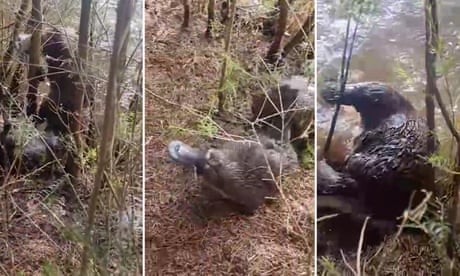‘They did not let up’: rare video of platypuses fighting captured by Tasmanian farmer

For 20 minutes Esme Atkinson stood near the bank of a dam at the farm where she works watching the two platypuses spinning each other around in circles, similar to a “crocodile roll”, and lift their bodies upright using their back tail in order to tussle with their feet.

Dr Gilad Bino, a platypus researcher at the University of New South Wales Centre for Ecosystem Science, said this behaviour is normal for male platypuses as they battle to be the alpha in the eyes of female platypuses in the lead up to breeding season in September.
Bino said it is not unusual for male platypuses, which are nocturnal and often skittish, to have scarring from the battle wounds around this time of year. Although it is rare for humans to spot this sparring behaviour.

Esme Atkinson captured and shared the video via Instagram describing the showdown as a “Platypus fight club!”. According to The Guardian, she spotted the contestants along the water’s edge near a dam on the farm where she works in northern Tasmania and watched the pugilistic proceedings for some 20 minutes. “They did not let up in the time I was there, I could have stayed for longer but felt I was imposing,” Atkinson’s quoted as saying.
The tussle she filmed is a vigorous one, to say the least, with much thrashing and grappling along the shoreline. Uncommon to actually spy though it might be (as the retiring, mainly nocturnal platypus is in general), the fight has a clear-cut explanation: It likely represents a territorial match between two male platypuses keen on spending some quality time with receptive females.

As the late-winter and spring breeding season approaches, male platypuses generally get more aggressive. And this mounting feistiness coincides with enhancement of their primary weapon, one that sets them apart from nearly all other mammals (and seems incongruous for such a cuddly-looking little bugger): a venomous spur on both of their hindlegs.
This time of year, the spurs enlarge, and the glands that supply them beef up venom production. (Female platypuses boast a vestigial spur structure when young, but it doesn’t deliver venom and usually falls off within their first year.)

Although it’s possible venomous spurs originally evolved as a defensive weapon – they land a very painful, though non-fatal, wound in humans – biologists believe their primary function in the male platypus these days is for duking it out over breeding territory and access to females. The spur can be “cocked” at a right angle to the hindleg when the platypus is ready to deliver a venom-barbed kick.